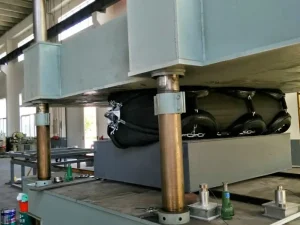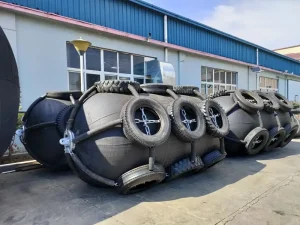Las defensas marinas actúan como protección en barcos y embarcaciones. Garantizan el atraque seguro de los barcos absorbiendo el impacto. Sin embargo, mucha gente se pregunta cómo estas defensas cumplen su función de forma tan perfecta. Se realizan varias pruebas para garantizar su excelente rendimiento. ¿Tiene curiosidad por saber cómo se realizan las pruebas de rendimiento de las defensas?
Conocer estas pruebas de rendimiento es crucial, sobre todo si se dedica al sector náutico. Estas pruebas garantizan que las defensas que ha comprado o preparado son seguras de usar. ¿Es usted nuevo en ese sistema de pruebas? No se preocupe. En este artículo, le explicaré cómo realizar pruebas de rendimiento de defensas sin complicaciones. Así que, ¡comencemos!
¿Por qué son importantes las pruebas Fender?

Como he dicho antes, las pruebas de las defensas garantizan que funcionan correctamente. Las defensas cuyo rendimiento no es satisfactorio no se utilizan para los buques. Con el tiempo, la calidad de las defensas se degrada, por lo que estas pruebas ayudan a determinar si son utilizables. He aquí la lista que indica la importancia de las pruebas de las defensas.
- El sistema de pruebas de los guardabarros garantiza su durabilidad. Pueden absorber golpes y vibraciones sin sufrir daños. De este modo, salvan las estructuras de los buques y embarcaciones.
- Una defensa que supera estas pruebas tiene una larga vida útil. Su estructura es robusta y puede soportar el duro entorno de los océanos.
- Un guardabarros probado le ahorra costes. Cuando no se prueba un guardabarros, éste funciona mal repetidamente. Su coste de reparación es mucho mayor. Pero un guardabarros probado le da tranquilidad en cuanto a su durabilidad. Así, las posibilidades de desgaste son mucho menores.
- Un sistema de pruebas de defensas garantiza la seguridad, pero las defensas que no se someten a pruebas son más propensas a sufrir accidentes debido a una estructura deficiente. Las pruebas de rendimiento de las defensas garantizan que puedan funcionar eficazmente en puertos con mucho tráfico.
Pasos para realizar pruebas de rendimiento de los guardabarros
Estoy bastante seguro de que su mente ha comprendido la importancia de las pruebas de guardabarros. ¿Verdad? Recuerde que estas pruebas se realizan en guardabarros que han estado en uso durante varios años. Usted no necesita tal prueba de funcionamiento si usted tiene defensas relativamente más nuevas. Ahora, zambullámonos y exploremos los pasos implicados en la realización de las pruebas de funcionamiento.
1- Instalación del equipo
Las pruebas de Fender comienzan con la selección de un lugar de pruebas. No recomiendo realizar estas pruebas en zonas húmedas. Además, necesitará algunas herramientas para empezar. Es mejor preparar esas herramientas y maquinas antes de empezar la prueba. Le ahorrará tiempo durante la prueba.
Las herramientas principales incluyen herramientas de medición de presión y temperatura, células de carga y cámaras ambientales. Asegúrese de que todas las herramientas funcionan correctamente, ya que su mal funcionamiento afectará a los resultados. En segundo lugar, primero debe comprobar el guardabarros a simple vista. Si está dañado por algún lado, la prueba no tiene sentido.
2- Realizar la prueba de compresión

Una vez que haya realizado una configuración completa para las pruebas, es hora de realizarlas. Entre una serie de pruebas, la primera es la prueba de compresión. Esta prueba comprueba la capacidad de absorción de energía de las defensas marinas. Antes de realizar esta prueba, quiero recordarle algunas consideraciones, como comprobar la máquina de compresión.
Esta máquina sujeta y comprime el guardabarros. Asegúrese de que tiene una compresión de nivel controlado. Después, coloque el guardabarros dentro de esta máquina. La posición del guardabarros es muy importante. Un guardabarros mal colocado se deteriorará incluso con una carga muy baja. Por lo tanto, colóquelo con precisión según la colocación en tiempo real.
Aplique lentamente la carga de forma controlada. Compruebe hasta qué punto el guardabarros puede soportar la carga. Después de utilizar la carga máxima, saque el guardabarros de la máquina. Compruebe el comportamiento del guardabarros debajo de la máquina. Observe el desgaste en cada lado. Si no encuentra roturas, pase al siguiente paso.
Lo más destacado: Las pruebas de compresión son la parte más crítica de las pruebas de rendimiento de Fender. ¿Por qué? Los guardabarros suelen estar sometidos a presión durante su uso y se comprimen en caso de impacto. Por lo tanto, esta prueba de compresión emula esas condiciones comprimiéndolo. Un guardabarros que soporta esta prueba es duradero, y viceversa.
3- Realización del ensayo de cizallamiento
En el ensayo de cizalladura, la fuerza se aplica paralelamente. Esta fuerza material prueba cómo se comportan las defensas marinas en caso de fuerza no deseada durante el atraque. Además, indica la estabilidad de la defensa ante cargas pesadas. Sin embargo, surge la pregunta: ¿Cómo se realiza esta prueba? Se lo explicaré de forma sencilla. En primer lugar, hay que utilizar una máquina de ensayo de cizalladura que aplique una fuerza lateral.
Coloque el guardabarros en esta máquina en una posición precisa. Conecte a esta máquina una célula de carga que mida la fuerza aplicada. A continuación, comience a aplicar la fuerza de cizallamiento de forma controlada. Mantenga la vista en el guardabarros y observe su comportamiento. Asegúrese de aplicar la fuerza hasta el límite específico. Observa los cambios que se producen en la estructura del guardabarros.
Además, los datos del ensayo de cizalladura se registrarán en forma de documento. Esto incluye la medición de la fuerza de cizallamiento máxima y el límite hasta el que la defensa puede soportarla. En caso de fallo, se registrará el motivo del mismo. Esto ayudará en el proceso de refabricación. Si un guardabarros supera esta prueba, puede declararse seguro para soportar cargas pesadas.
4- Prueba de resistencia a la intemperie

Esta prueba comprueba la durabilidad de las defensas marinas. Como sabe, las defensas marinas se enfrentan a duras condiciones meteorológicas en los océanos, como el agua salada. Además, la fluctuación de la temperatura y la exposición VU son otros factores que afectan a las defensas. Así pues, esta prueba revela la resistencia de la estructura de las defensas marinas en esas condiciones.
Para realizar esta prueba se aplican condiciones en tiempo real. ¿CÓMO? Esta prueba se realiza en una cámara ambiental. Esta cámara contiene todas las condiciones duras a las que se enfrenta un guardabarros. Por ejemplo, esta cámara contiene una configuración para exposición a rayos UV, fluctuaciones de temperatura y agua salada.
Por lo tanto, basta con colocar el guardabarros en esta cámara. Aplique esas condiciones individualmente y analice la respuesta del guardabarros a cada condición. Asegúrese de que estas condiciones se aplican de forma muy controlada. Es duradero y adecuado si el guardabarros se mantiene en buen estado después de estas duras condiciones.
Lo más destacado: Estas cámaras ambientales también exponen las defensas a diferentes temperaturas. Recuerde que las defensas marinas se someten a diferentes niveles de calor durante su uso. Por lo tanto, probarlas con el parámetro de temperatura también es crucial. Estas cámaras pueden proporcionar tanto temperaturas extremadamente bajas como altas.
5- Pruebas de absorción de energía y fuerza de reacción
Tanto la absorción de energía como la fuerza de reacción desempeñan un papel fundamental en el rendimiento de los guardabarros. Las pruebas de absorción de energía determinan cuánta energía absorbe una defensa ante un impacto. Recuerde que las defensas absorben energía durante la eclosión con estructuras de atraque. Una buena defensa absorberá más energía y viceversa.
En este proceso se utiliza una máquina de ensayo de absorción de energía. En el lugar del guardabarros se golpea con fuerza la máquina. La máquina comprueba el nivel de absorción de energía. Del mismo modo, la comprobación de la fuerza de reacción de los guardabarros se realiza mediante máquinas específicas. La fuerza de reacción indica cuánta fuerza ejerce un guardabarros una vez comprimido.
En la prueba de fuerza de reacción, el guardabarros se comprime con carga. Una vez que está totalmente comprimido, la máquina libera la presión repentinamente. El guardabarros ejerce cierta fuerza y vuelve a su posición normal. La máquina detecta la cantidad de fuerza ejercida por el guardabarros. El guardabarros debe ejercer la máxima fuerza. De este modo, recuperará su rigidez original tras enfrentarse a la compresión.
6- Análisis de los resultados de las pruebas
¿Me ha seguido y ha realizado todas las pruebas? Ahora es el momento de evaluar los resultados de esas pruebas. Este último paso revela el estado real del guardabarros. Para ello, simplemente recopile los datos que haya obtenido de cada prueba. Puede ser en fotografías o en forma numérica. Para un mejor análisis, extienda todos los datos recogidos en la tabla.
Después, inspeccione cada dato. Por ejemplo, analizar cómo el Faender mostró resultados en la prueba de compresión. Además, inspeccione hasta qué límite resistió la fuerza cortante. En la cámara ambiental, ¿cómo se comportó el guardabarros? Todas estas observaciones le darán el resultado final sobre la durabilidad y seguridad del guardabarros.
Preguntas frecuentes
¿Las pruebas de rendimiento de Fender son manuales o automatizadas?
Las pruebas de rendimiento de los guardabarros están automatizadas. También puede realizarse manualmente. Sin embargo, aumentarán las posibilidades de que se produzcan errores humanos, por lo que no obtendrá los resultados deseados. Recomiendo utilizar máquinas para automatizar el proceso de prueba.
¿Qué grado de dificultad entrañan las pruebas de rendimiento?
La dificultad de las pruebas de rendimiento de Fender depende de muchos factores. No es difícil si se dispone de un lugar de pruebas adecuado y de todas las herramientas necesarias. Solo tienes que preparar esas herramientas y analizar los resultados.
¿Cuáles son los tipos de pruebas de rendimiento de Fender?
El sistema de pruebas Fender incluye varios tipos de pruebas. Entre ellos se incluyen
- Ensayo de cizallamiento
- Prueba meteorológica
- Prueba de compresión
- Prueba de fuerza de reacción
- Prueba de absorción de energía
Conclusión
Las pruebas de rendimiento de las defensas son una serie de ensayos que garantizan su durabilidad. En este artículo, he analizado el proceso completo de realización de dichas pruebas. Cada prueba tiene el máximo valor, ya que determina el estado de la defensa.
Las principales pruebas son las de compresión, cizallamiento, absorción de energía y resistencia a la intemperie. Todas estas pruebas deben realizarse de forma controlada. Un pequeño error en cualquier paso puede afectar a los resultados globales. Además, recomiendo usar sólo defensas marinas probadas. Esas defensas prometen durabilidad, manteniendo a salvo el cuerpo de la embarcación.
